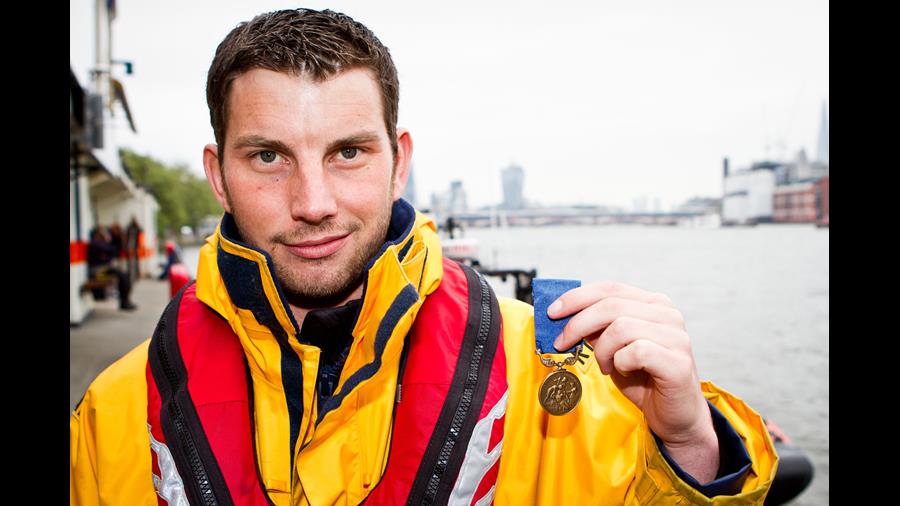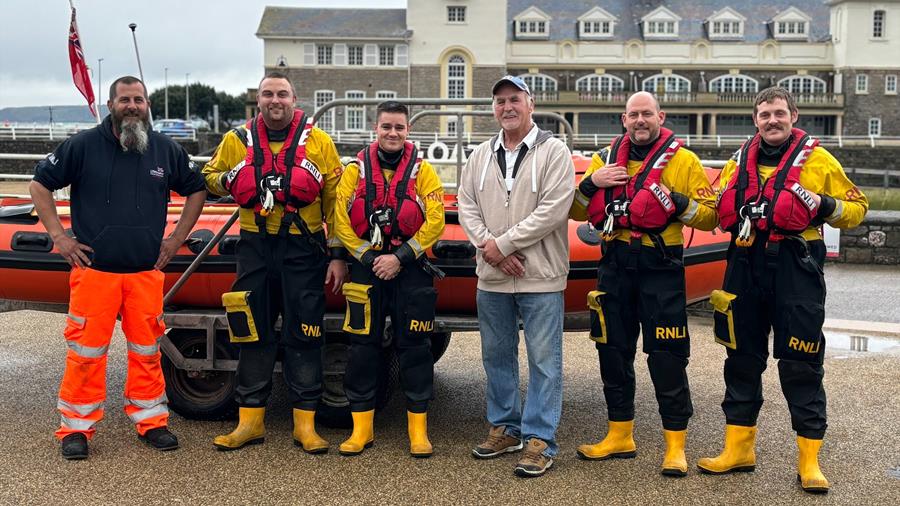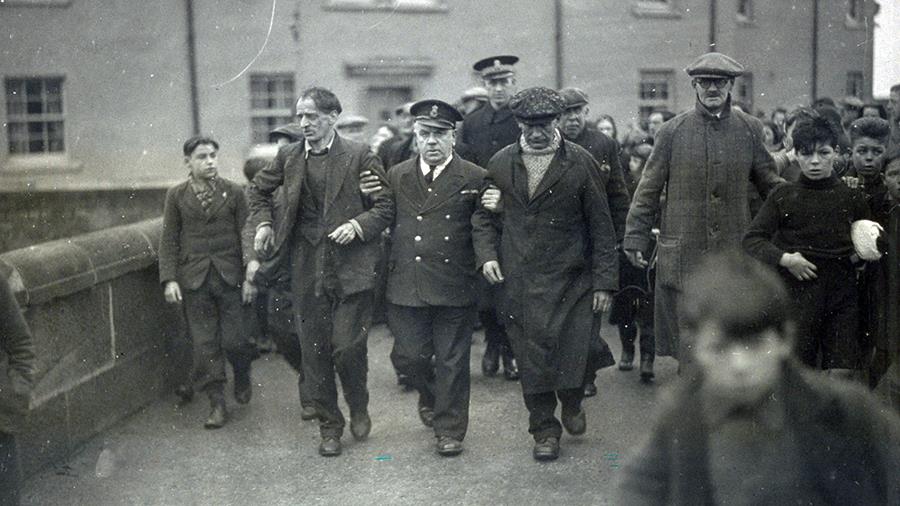

The makings of a medal-earning rescue
RNLI lifesavers give a lot: not least, their time and commitment. In exceptional cases, the charity gives them something in return – an RNLI Medal for Gallantry. We take a closer look at these prized – and much-deserved – awards, and shine a light on some of those who have headed into conditions most of us would head away from.
As with a lot of life’s callings, voluntarily crewing a lifeboat isn’t something you do for plaudits and recognition. It’s a selfless act. One that frequently involves people putting themselves at the mercy of the elements. RNLI lifesavers make the point that saving a life is reward enough. Sometimes though, particular acts of courage are recognised by an RNLI Gallantry award, which could be in the form of a Chair Letter of Thanks, the Thanks of the Institution, or a Bronze, Silver or Gold Medal. But when crew members and lifeguards are launching into danger daily, how do you define a medal-earning rescue? And just how often are medals awarded?
With courage, nothing is impossible
From the RNLI’s inception in 1824, the charity’s founder – Sir William Hillary – believed that exceptional bravery should be recognised. The awarding of a medal was discretionary, and based on the evidence of a particular rescue. Two centuries on, this still holds true – a committee carefully assesses each case, then makes recommendations to the Trustees, who make the final decision.
Shortly after the charity was founded, Charles Fremantle – while serving with the Lymington Coastguard service – became the RNLI’s first Gold Medal recipient, after he swam out to a stranded ship off the Christchurch coast.
For the vision and determination he showed in establishing the Institution, Sir William Hillary himself was awarded an Honorary Gold Medal, in 1825. In his time as a member of the Douglas crew on the Isle of Man, Sir William helped to save over 300 lives – despite the fact that he couldn’t swim! Perhaps there’s no better example of the RNLI’s motto: ‘With courage, nothing is impossible’. Sir William would be awarded a further three Gold Medals for courageous rescues.
Dogged tenacity
In 1917, the Bronze Medal for Gallantry was introduced to recognise the Cromer crew, who launched 7 times in 14 hours to rescue 16 sailors aboard the Pyrin and 11 more from the wrecked SS Fernebo. With many young men called away to serve in the First World War, Cromer’s crew had an average age of 50 – and several of the crew members were nearly 70 years old.
Arriving back on shore to cheering crowds at 1am, the lifesavers were praised for their ‘courage and dogged tenacity’. The RNLI coxswain that day was Henry Blogg, who was awarded a Gold Medal for Gallantry. It wouldn’t be his last.
Three men in a boat
The first RNLI medals featured the head of the charity’s Patron, King George IV, along with the name of the service as it was known then: ROYAL NATIONAL INSTITUTION FOR THE PRESERVATION OF LIFE FROM SHIP-WRECK. On the reverse was a scene depicting three men in a lifeboat – one rescuing a survivor. Inscribed were the words: LET NOT THE DEEP SWALLOW ME UP. These words were adapted from a psalm: ‘Let not the water flood overflow me, neither let the deep swallow me up’. Today’s medals bear the same inscription.
Over the years, the design reflected the monarch of the era. But on his accession to the throne, King George VI directed that only medals personally awarded by him should carry his effigy. So, in 1937, a new medal was struck, featuring the head of the RNLI’s founder, Sir William Hillary.
Sometimes, lifesavers battle more than just waves
When – in 1940 – enemy aircraft dropped 10 bombs near the crew aboard the Arbroath lifeboat, the volunteers reported that the explosion ‘seemed to lift the lifeboat out of the water and made all the air-cases inside her rattle’. Undaunted, the Arbroath crew continued their mission, saving the seven survivors aboard the barge, Foremost. The RNLI awarded Coxswain William Swankie the Bronze Medal for Gallantry, and the crew received the inscribed Thanks of the Institution.
The history makers
When Porthcawl Helm Aileen Jones braved gale-force conditions to save two fishermen in 2005, she didn’t only make a rescue – she made history. Aileen was the first female crew member to receive a Bronze Medal for Gallantry, and the first woman in 116 years to be awarded an RNLI medal. But recognition isn’t limited to lifeboat crews. In 2003, after saving a swimmer off Fistral Beach, Newquay, Rodney MacDonald received his own Bronze Medal for Gallantry – the first RNLI lifeguard to do so. Three years later, Sophie Grant-Crookston became the second, and the first female lifeguard to earn an RNLI medal.
Some notable lifesavers
1830
For the steely daring shown in launches to the Eclipse and the St George, RNLI founder Sir William Hillary is awarded a Gold Medal for each, to go with the Gold earned in 1827.
1838
Lighthouse-keeper’s daughter Grace Darling risks her life, rowing to rescue the survivors of the wrecked steamship Forfarshire. She becomes the first woman to be awarded an RNLI medal.
1879
Gallantry Medals are awarded to four female members of the Prideaux-Brune family – Ellen Frances, Gertrude Rose, Mary Katherine and Beatrice May – as well as Nora O'Shaughnessy – for rowing through heavy surf in Padstow Harbour to rescue a sailor whose boat had capsized.
1943
For the rescue of 19 aboard HM Almondine, Humber Coxswain Robert Cross is awarded a second Gold Medal, to go with his two Bronze Medals and three Silver Medals.
1947
After 53 years’ service, aged 71, RNLI legend Henry Blogg retires. With his Cromer crewmates, Henry helped save 873 lives. His three RNLI Gold Medals and four Silver Medals make him the most decorated volunteer in our history.
1979
Humber Coxswain Brian Bevan MBE receives Bronze, Silver and Gold after leading three medal-earning rescues in just 7 weeks.
1997
Lerwick lifesaver Hewitt Clark receives the Gold Medal, and is the most recent recipient of the RNLI’s highest honour. He is one of only three living Gold Medal recipients – the others being Brian Bevan and former Torbay Second Coxswain, Keith Bower.
2012
The Bronze Medal awarded to Nicola-Jane Bradbury makes the Port Isaac crew member the most recent female recipient. It was given for her part in the rescue of a father and son off the Cornish coast.
2020
Three RNLI coxswains, Eugene Kehoe (Kilmore Quay), Roy Abrahamsson (Dunmore East) and Eamonn O'Rourke (Rosslare Harbour), are awarded Bronze Medals for Gallantry for their part in the Lily B rescue. In a 12-hour service to a 4,000-tonne cargo vessel which had lost all power, the crews battled horrendous conditions to save the nine lives aboard.
2024
The Penlee crew are awarded Silver Medal Service Certificates – with Coxswain Patch Harvey receiving a Silver Medal – for rescuing eight from a yacht in hurricane conditions near Porthleven.
Courage knows no bounds
Although most medal recipients are RNLI crew members, often the earlier medallists were not crew, and included people such as Grace Darling, members of the coastguard, the Navy, fishers and people from the local community. Almost all medals are awarded for a particular service, but a small number of Honorary Medals have also been issued. Since 1824, 119 Gold Medals for Gallantry and 32 Honorary Gold Medals have been awarded.
Due to the unique nature of each incident, there will always be a degree of subjectivity in making the assessment. And it’s important to remember that a conclusion arrived at in 1830 might be different to a decision made in 1930, or today. One thing that will never change though, is the readiness of RNLI lifesavers to be there, come what may – to be dependable, trustworthy, selfless and courageous.
You may also enjoy the following












